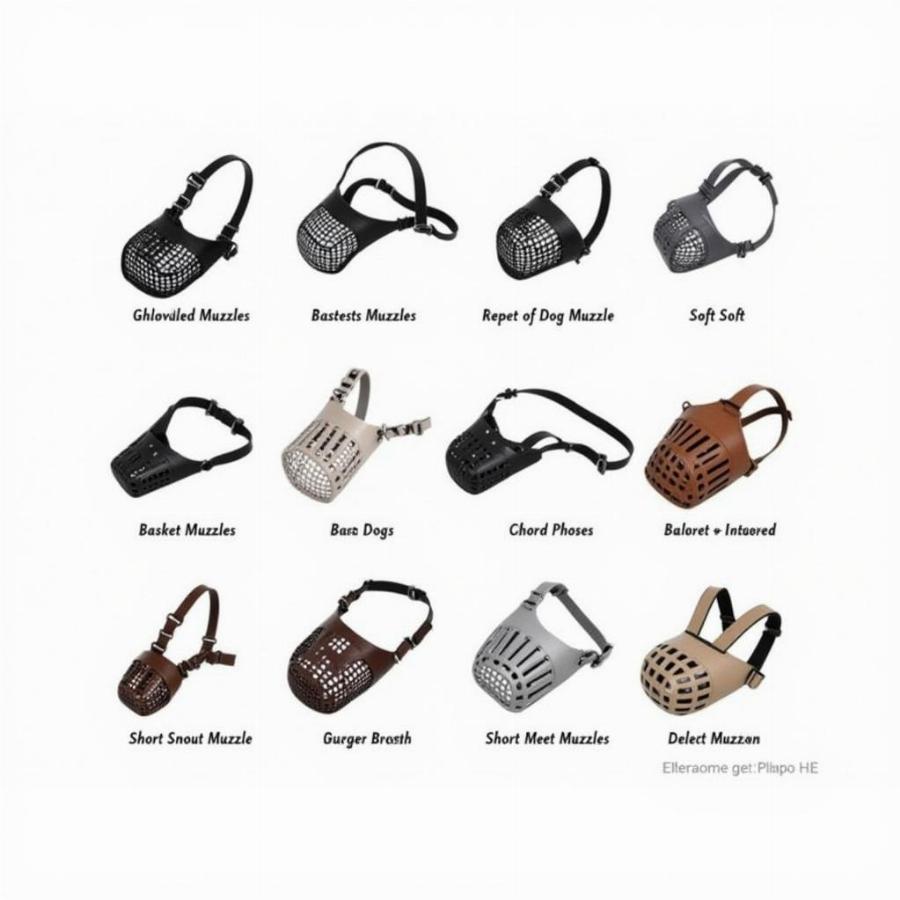Knowing how to measure a dog for a muzzle is crucial for their comfort and safety. An ill-fitting muzzle can cause chafing, restrict breathing, and even lead to injury. This guide provides a step-by-step approach to ensure a perfect fit for your furry friend.
Understanding the Importance of Correct Muzzle Sizing
A properly fitted muzzle allows your dog to pant, drink, and even take treats, while preventing biting or unwanted scavenging. Accurate measurements are the first step in finding the right muzzle. Taking the time to measure your dog correctly will make the experience more comfortable for them and give you peace of mind.
Taking the Necessary Measurements: A Step-by-Step Guide
Here’s a detailed guide on how to measure a dog for a muzzle:
- Circumference: Measure the circumference of your dog’s snout about one inch below their eyes. This is the widest part of their snout and the most important measurement for muzzle fit. Make sure the tape measure is snug but not too tight.
- Length: Measure the length of your dog’s snout from the tip of their nose to the point where their snout meets their forehead (just below the eyes). This measurement ensures the muzzle isn’t too long or too short.
- Width: Measure the width of your dog’s snout at its widest point. This measurement helps determine the muzzle’s breadth.
- Height: Measure the height of your dog’s snout from the top of their nose to the bottom of their jaw. This measurement is important for ensuring the muzzle doesn’t restrict their breathing or ability to pant.
- Head Circumference: While not always required, measuring the circumference of your dog’s head, just behind the ears, can be helpful for certain muzzle styles.
Why is Measuring My Dog for a Muzzle So Important?
A muzzle that’s too tight can restrict breathing and cause discomfort, while one that’s too loose can easily be slipped off. Proper measurements ensure a comfortable and secure fit. how to measure your dog for a muzzle provides detailed information on getting the right fit.
Different Muzzle Types and Their Sizing
 Different Types of Dog Muzzles
Different Types of Dog Muzzles
Different muzzle types have slightly different sizing requirements. Basket muzzles, for instance, require more precise measurements to ensure proper ventilation and comfort. Soft muzzles are generally more forgiving in terms of sizing but should still fit snugly without restricting breathing. Short-snouted breeds require specialized muzzles designed for their unique facial structure.
Tips for a Smooth Measuring Experience
Making the measuring process a positive experience for your dog is essential. Use positive reinforcement, such as treats and praise. A relaxed dog will make it easier to obtain accurate measurements. how to measure muzzle for dog offers further guidance on how to handle different breeds and temperaments.
Common Mistakes to Avoid
Avoid using a rigid ruler; a flexible tape measure is essential for accurate measurements. Don’t pull the tape too tight, and ensure the dog is comfortable throughout the process. Rushing the process can lead to inaccurate measurements. Take your time and repeat the process if necessary.
Expert Advice on Muzzle Fitting
“A proper muzzle fit allows a dog to pant, drink, and receive treats comfortably. If your dog seems distressed or struggles to breathe, the muzzle is likely too tight,” says Dr. Emily Carter, DVM, a certified veterinary behaviorist.
Conclusion
Accurately measuring your dog for a muzzle is vital for their comfort and safety. Follow these steps and consult our resources to ensure a perfect fit. A well-fitted muzzle benefits both you and your canine companion. Remember to prioritize their comfort and well-being throughout the process. muzzles for small dogs may offer more specific advice for smaller breeds.
FAQ
- What type of muzzle is best for my dog? The best muzzle type depends on your dog’s breed, size, and the reason for using a muzzle. Consult with a veterinarian or professional dog trainer for recommendations.
- How often should I measure my dog for a muzzle? If your dog is still growing, re-measure every few months. For adult dogs, occasional checks are sufficient, especially if they gain or lose weight.
- Can my dog wear a muzzle all day? No, muzzles should not be worn for extended periods. They should be used for specific situations and removed regularly to allow your dog to pant, drink, and be comfortable.
- What if my dog’s measurements fall between sizes? It’s generally best to choose the larger size to ensure comfort and prevent restriction.
- Can I use a muzzle to stop my dog from barking? While some muzzles can reduce barking, they should not be used as a long-term solution. Address the underlying cause of the barking with training and behavioral modification.
- How do I introduce my dog to a muzzle? Introduce the muzzle gradually and positively, using treats and praise. Make it a positive experience to help your dog associate the muzzle with good things.
- Where can I buy a quality dog muzzle? You can find quality dog muzzles at pet stores, online retailers, and from some veterinarians. dog ingrown whisker discusses another common canine issue.
Beaut Dogs is your ultimate resource for all things related to dog care, offering expert advice, breed-specific information, and practical tips for responsible dog ownership. For personalized support, contact us at Email: [email protected]. We at Beaut Dogs are committed to helping you provide the best possible care for your beloved canine companion.